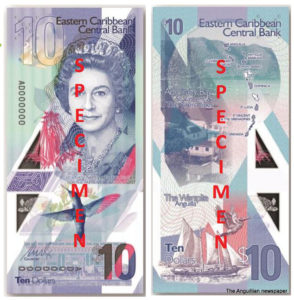
features of the current note. It depicts the Admiralty Bay –
St Vincent and the Grenadines and the Warspite – Anguilla
The eight-member territories of the Eastern Caribbean Central Bank and the Monetary Council, including Anguilla, will see a change in the to the original paper notes as from June 2019.
The change of the paper notes will be to polymer – a material similarly used over the past years by a number of regional and international countries. The ECCB is however the first Central Bank in the Caribbean to issue an entire family of banknotes in polymer.
The change-over from paper to polymer, will commence with the new 50-dollar notes, followed by the 100, 20 and 10-dollar banknotes in September, 2019, and the 5-dollar note in 2020.
It has been pointed out that while the changeover is in progress, both the polymer and the paper banknotes will co-circulate.
The ECCB has explained that polymer banknotes are produced from a thin, transparent and flexible plastic film, made from polypropylene. The key benefits of polymer notes have been identified as being difficult to counterfeit; resistant to water and other liquids; more resistant to dirt and moisture; cleaner for longer periods; more hygienic; durable; difficult to tear; and eco-friendly.
The following tips about handling polymer banknotes, have been issued by the ECCB: Wipe soiled notes, dry wet notes; Do not use or apply other forms of heat or leave to hot temperatures for extended periods; avoid creasing and crumpling, acute folding or stapling; flatten crumbled or creased notes by applying pressure to them or curling them in your hand; repair torn notes with clear tape and use again.
Further information, as required, will be given later.







